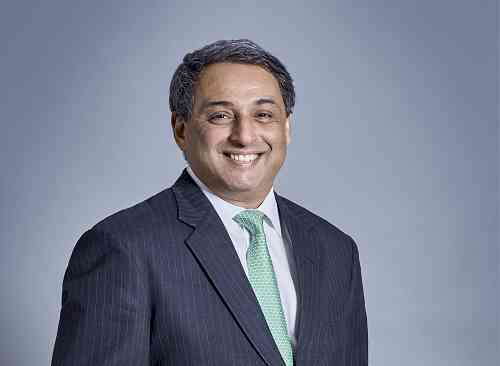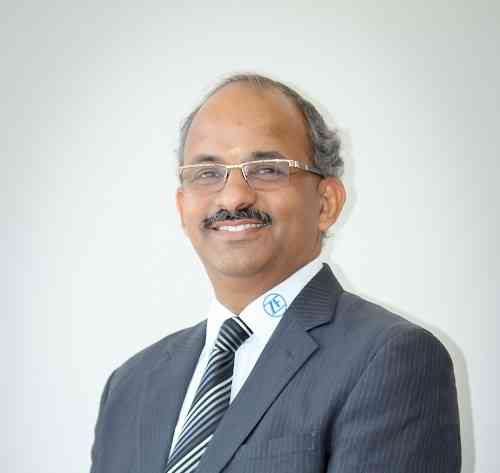Reactions to Union Budget 2021-22
The Budget was presented by the Union Finance Minister today

T. V. Narendran, CEO & MD, Tata Steel

"The Finance Minister presented a very progressive and growth oriented budget while retaining the government’s focussed approach on infrastructure-led economic revival. We welcome all the proposed reforms. However, the implementation of these reforms will be critical for the benefits to percolate across the economy.
The increased Capex in the infrastructure sector, including the healthcare infrastructure, will have a multiplier effect as it will create demand across product categories, including steel. Announcements like the National Rail Plan, Jal Jeevan Mission, and City Gas Distribution Network will generate new employment opportunities and spur demand in multiple sectors.
The government has done a balancing act of infrastructure development between the rural and urban areas which will again have a positive impact on the economy and the society at large. The Budget has also tried to address myriad concerns of the informal sector, including the migrant workers, by announcing the social security scheme for the gig economy workers, which is again a welcome step.
Exemption of duty on steel scrap and reduction of customs duty on steel products would benefit the MSME sector. However, the reduction of customs duty on steel products will have no significant impact on the steel industry as most of the steel imported into the country today comes from countries with whom we have an FTA (Free Trade Agreement) and hence they enjoy zero import duty.
The government’s consistent effort to address the issues related to ease of doing business is a welcome approach as the Budget has further widened the scope of faceless taxation that will eventually reduce litigation.
Reforms and measures including Production Linked Incentive (PLI) scheme, setting up of Development Finance Institution (DFI), Asset Reconstruction and Asset Management Company, Voluntary Vehicle Scrappage Policy, simplification of regulatory complexities, extension of tax holiday for startups will provide much needed fillip to the economy and enable growth.
The government is aggressive on its divestment plans and has also reiterated its focus on the monetisation of government assets.
Overall, we can call it a reformist Budget as it recognises and emphasises the participation of private players in all key areas, including the financial sector."
Dr. Krishna Ella, Chairman & Managing Director, Bharat Biotech
“It’s a great step ahead, and far-reaching budget announcement, providing ₹35,000 crore for Covid-19 vaccination in 2021-22. The Finance Minister commitment providing more funds in order to contain the Coronavirus pandemic spread in the country and provide an effective, smooth path for the vaccination scheme will help contain, and lead our nation towards accomplishing a covid-19 disease free Bharat.
The lay out plan of a ₹64,180 crore spending plan for healthcare over the next six years to be spent on primary, secondary and tertiary healthcare, in addition to the National Health Mission is also a welcome move, which will strengthen public health services as 17,000 rural and 11,000 urban health and wellness centres and integrated public health labs to be set up in each district. The government focus, on three areas - preventive health, curative health and well-being, is also very reassuring.” Dr. Ella added, with this landmark budget the Government of India has signalled its intention to make health a cornerstone of the future success of our country. The allocation to vaccines signals a shift to preventive health care, a validation of the fact that vaccines are the most cost effective health care interventions."
Suchitra Ella, Joint Managing Director, Bharat Biotech
“The new health infra schemes with significantly higher outlay of Rs 35,000 crore for Bharat’s mega COVID19 vaccination drive is a huge fiscal medicine to contain the pandemic, reduce disease burden for the population, and the economy. A record total outlay of Rs 2,23,846 crore for health and wellbeing aimed to boost the health and well-being of the nation, is also a well-thought announcement in this budget, with focus on preventive, and curative health. It’s encouraging to note the creation of 9 Bio Safety Lab-III (BSL-3) in this Budget, that will boost research & scientific discoveries. With this landmark budget the Government of India has signalled its intention to make health a cornerstone of the future success of our country."
Harish Manian, CEO, MGM Healthcare
"We are delighted to note that the budget session was introduced with the announcement of increase in the healthcare budget by 137%. The government's holistic approach to healthcare will help in creating awareness on preventive healthcare. post-pandemic Learning from the recent pandemic, the move to establish more number of critical care blocks in Hospitals and strengthening of primary, secondary and tertiary care is a much need move by the Government. The launch of Misision Poshan 2.0 is a commendable move to prevent over 50,000 child deaths annually. Coupled with initiatives like clean water, clean air and clean environment, it will act as a binding force to achieve a universal health coverage. Detection of new and emerging diseases like COVID have been given the right impetus and will encourage all-round development and preparedness towards a progressive and safe future."
Dr. Alok Roy, Chair, FICCI, Health Services Committee and Chairman Medica Group of Hospitals
“India Inc. and especially the Healthcare industry which has been battling the demon of COVID-19 and its aftermath should consider this year’s budget a blessing. Quite rightly, the budget has focused on health and well-being, infrastructural reforms, development of human capital and minimum government and maximum governance. The very fact that Government has put health as the first pillar shows that finally it is being considered as the prerequisite to ensure economic well-being of the country. Budget 21-22 seems realistic, constructive, and Hon’ble Finance Minister showed her commitment towards the healthcare sector, which needed a boost urgently. The Aatmanirbhar Health Yojana in addition to the National Health Mission with an outlay of INR 64,180 crore over six years is a welcome move, towards strengthening primary, secondary and tertiary healthcare in the country, addressing the Preventive, Curative, and Wellbeing of the population. This will also intend to develop capacities of health care systems, develop institutions for detection and cure of new and emerging disease as the first step to boost rural health and keep country ready for emergency handling of pandemic situations. Further, increasing access to pneumococcal vaccine to all states and budget outlay for health and welfare by the allocation this year of INR 2,23,846 crore in the healthcare sector a rise by 137% as compared to previous year will prove to be a major increase in the public health and pharmaceuticals sector. This will definitely strengthen the National Centre for Disease Control and make India future ready for any further health crises. With the incorporation of 17,788 rural and 11,024 urban health and wellness centers, the budget rightly addresses the need to reach the last mile population. The decision to set up integrated public health labs in all districts and 3382 block public health units in 11 states along with critical care hospital blocks in 602 districts and 12 central institutions is creditable but more might be required in a country where the patient doctor ratio is abysmally poor. Expansion of the Integrated Health Information Portal to all States/UTs to connect all public health labs is a step ahead towards digitalization and is a positive move. India has done exceptionally well considering the density of populace in talking the pandemic. Setting aside INR 35,000 crore and more if required for COVID-19 vaccination drive is laudable and shows that Government has prioritized the sector. India unfortunately has the highest mortality rate for children, the decision to launch Mission Poshan 2.0 is a praiseworthy move to prevent over 50,000 child deaths annually. The INR 2,217 crore outlay for 42 urban centers to tackle air pollution, one of the deadliest pandemic which is obliterating mankind for years and acts as slow poisoning is also commendable. The resolution to set up integrated public health labs in each district about 3,382 block public health units in 11 states is noteworthy. Establishing critical care blocks in Hospitals is essential from our learning from the recent pandemic and a right move by the Government. Overall the proposals made in the Budget 21-22, would make quality healthcare accessible and affordable, besides standardizing healthcare infrastructure across the country. We await the on ground implementation and operational details of the scheme now.”
Dr. Alok Khullar, CEO, Gleneagles Global Health City, Chennai
“The budget’s focus to strengthen the Indian healthcare infrastructure is really welcoming as it will help us to be well-prepared to handle disease outbreaks/pandemic. This move will reduce the burden on the healthcare workers and ensure increased accessibility for receiving critical and emergency care. Initiatives to promote fitness and sanitation will help in preventing lifestyle issues and reduce the probability of disease outbreak among the rural areas. The proposed set-up for a viability gap funding window to set up hospitals in PPP mode will help healthcare institutions to expand their network to smaller districts. The PM Jan Arogya Yojana would be a real boost that would help the Indian population to receive advanced technology care in their hometowns and reduce their burden of travelling to metro cities. However, the decision to levy a 5 percent cess on import of medical equipment could have been avoided, as it’s used for advanced life-saving measures and helps India to be abreast with high technologies used around the world for healthcare.”
Dr. Arun Kalyanasundaram, Director, Pro-med Hospital, Chennai
“The increased allocations for healthcare will boost the country’s healthcare sector and help in generation of more jobs and availability of skilled professionals that would help in meeting the increasing demand for accessible and affordable healthcare. The budget has adequate importance to preventive healthcare which is the need of the hour. After a difficult year for the healthcare sector, we hope that the announced measures would reduce the burden in the sector and we also look forward to working with the Govt to ensure quicker and faster administration of Covid-19 vaccines for all. The set-up of increased number of healthcare facilities will improve the healthcare network and reduce the turnaround of avoidable mortalities.”
Saranavakumar Rajan, General Manager – Operations, Rainbow Children’s Hospital, Chennai
“The holistic approach towards healthcare in this year’s budget is really commendable. Measures to tackle problems of air pollution and sanitation will aid in preventive healthcare and improve one’s well-being. The budget’s focus towards improving the health of the mother and a child with the Poshan Abhiyan scheme to enrich their nutritional intake, will create more awareness on the importanc e of consuming a well-balanced meal for a healthy living. We look forward to work together with the Govt in its efforts to strengthen the healthcare infrastructure among rural parts of India. This move would help in reducing the maternal and infant mortality rate as their deaths often occur as a result of inaccessibility to hospitals.”
A Ganesan, Group Vice Chairman, Neuberg Diagnostics
“The honorable finance minister has presented a very progressive budget. With a substantial increase in healthcare outlay, the government has given a much-needed shot in the sector's arm. With a substantial increase in healthcare outlay and key emphasis on public-private partnerships, the entire value-chain in the healthcare sector will gain new momentum and will see major collaborations amongst stakeholders. The announcements of centrally funded – Aatmanirbhar Health Yojana will strengthen our primary, secondary and tertiary healthcare, and setting up of 15 health emergency centers with a focus on curative and preventive health and wellbeing will scale up the delivery of affordable healthcare services”.
Anand Srinivasan, Managing Director, Covestro
"The announcement of the budget by the Honorable Finance Minister in the midst of a pandemic situation has indeed been a very progressive one. The focus on the implementation of various agendas is a clear sign of a robust economic objective for the country. With further inclusion of green initiatives that focus on sustainability and a circular economy will definitely stimulate the economy to be one of the responsible countries across the globe. The budget has aimed to boost the manufacturing sectors by emphasizing the overall well-being of the economy. Calibrated changes in customs duty on certain items will trigger local production and boost manufacturing under Atmanirbhar Bharat. The Government's ambition towards a production-linked-incentive scheme will help in maintaining the momentum across manufacturing sectors. This has potential to be a great move for the chemical industry."
Ajay Piramal, Chairman, Piramal Group

“I would like to commend the Finance Minister for a well-balanced and realistic Union Budget 2021-22 designed to put India’s ongoing business cycle recovery on a much more solid foundation. The Budget’s high focus on public capital expenditure, relaxing fiscal deficit targets and concrete plans to support financial markets through recapitalisation of public sector banks, and an asset reconstruction company for bad loans will provide the necessary impetus to restore economic growth. While the Budget is cognizant of the country’s immediate economic needs, it also lays out a medium term vision of 3-5 years.
Furthermore, the introduction of a Development Finance Institution (DFI) to fund long term projects will complement the high focus on infrastructure. With banks remaining evasive towards long term institutional exposures, the DFI is expected to ensure availability of credit for projects with long gestation periods.”
Manit Jain, Chairman, FICCI ARISE; Co-founder, The Heritage Group of Schools
“In order to fulfil the objectives established by the National Education Policy, spends in the education sector need to go up substantially. Given the economic crisis that we are in due to Covid and that there several competing social sectors that demand great attention, it is high time that the State and Central governments invite private capital to invest in education. This would mean higher investments through the private sector and FDI which could then be regulated by a government body.
As per UNDP estimates, the total financial requirement for India to reach SDG 4 by 2030 averages $173 billion per year, far exceeding the current government budget of $76.4 billion a year for education. Government schools spend about Rs 24,000-30,000 per child per annum, while in private schools, 91% of students pay lower than Rs 24,000 per annum. In contrast the average per student expense in the US is about $13,000 per annum.
Schools will only invest in post-Covid-19 technologies if there is some predictability in regulation and freedom of salaries, fees, and curriculum. We have been wishing for opening up and formalising the sector and ensuring long term responsible and patient capital, giving the much- needed confidence to potential investors to invest in the sector and expect legitimate RoI as spoken about several times in the past.”
Sunil Dahiya, Executive Vice President, Wadhwani Opportunity at Wadhwani Foundation
“On the National Apprenticeship Scheme of 3000 crore - The proposed amendment of the Apprenticeship Act in the. Budget has the potential to reboot and revitalize our education and training systems with a view to further enhance apprenticeship opportunities for our youth. Apprenticeship could be the best model to skill India’s blue-collar workforce as it will transform the student into a fully-trained industry executive with real-time exposure to shop-floor dynamics. It will not just enhance employability and reduce joblessness, but from an employer perspective, it will lead to improved skills, productivity and professionalism.”
Aditya Malik, CEO & MD, Talentedge
The Union Budget 2021-22 has proposed some forward-looking measures for the education sector in the country. The proposal to set up 100 new Sainik schools in partnership with NGOs, the private sector and the states will not only expand the school base in this area but will also bring in synergies from the NGO and private sector. The proposal for creating new formal umbrella structures in 9 states will also be good for coordination of states and bringing in synergies. There are also some good proposals for higher education including the registration of Higher Education Commission to act as an umbrella body with 4 separate vehicles for standard-setting, accreditation, regulation and funding. The government has also announced several proposals for scheduled caste and scheduled tribe students which will help bring them into mainstream education. This includes the establishment of 750 Eklavya model schools in tribal areas and the allotment of Rs 35,219 crore for the benefit of these students for the next six years. The outlay for the Eklavya schools has also been increased.
The proposal to strengthen over 15,000 schools qualitatively under the new National Education Policy (NEP) is also the need of the hour especially to align with the vision of the NEP which talks of use of technology and digitization of education. These schools will act as exemplar schools in their regions for mentoring others.
The proposal to amend the Apprentice Act to further enhance apprenticeship opportunities for our youth is forward looking and will help this sector. At the same time, the National Apprenticeship Promotion Scheme of 2016 will be enhanced to provide apprenticeship opportunities for students. The proposal to realign the National Apprenticeship Training Scheme (NATS) will provide post-education apprenticeship, training to graduates and diploma holders in engineering. This will further the government’s initiative for an Atma Nirbhar Bharat.”
Vishnu Karthik, CEO Xperiential Learning Systems and Director, The Heritage School
“Education sector has been seriously hit post Covid both in terms of financial sustainability and also in terms of learning outcomes. This budget hasn't had anything specific to expand budgetary spend to offset covid impact. But it is not surprising as there is not much fiscal cushion this year for the Government. Setting up 100 sainik schools is a good step but would at best be a small ripple in terms of impact. But the 750 eklavya model for impoverished communities is a great step but we hope that private operators are invited to set up model schools. We hoped to see more clarity on setting up institutions to strengthen assessments on critical skills enumerated by the NEP and hope that the MHRD provides clarity on this sooner.”
Shishir Jaipuria, Chairman, Seth Anandram Jaipuria Group of Educational Institutions
“The education sector will get to benefit from the Union Budget presented by the honourable Finance Minister, Nirmala Sitharaman, today. The budget paves the way for a phased implementation of the National Education Policy with the first step of bringing 15,000 schools across India under the policy’s ambit. This will help minimize any widespread disruption in the pedagogical processes or curriculum, as these schools will serve as models for the other schools to follow. The other schools will draw their lessons from these model schools for a smoother implementation of NEP in the future. I also welcome the move to set up Sainik Schools and Eklavya Schools as these will help bring more equality in education. I strongly endorse the proposal for National Professional Standards for Teachers (NPST), as expressed in annexure 5 of the budget. This proposal will set an important benchmark for teaching standards in Indian educational institutes.”
Charu Wahi, Principal Nirmal Bhartia School
“The prolonged closure of educational institutions for almost a year due to the Covid-19 pandemic has put immense duress with schools feeling the heat of financial stress now.
The qualitative strengthening of more than 15,000 schools under the New Education Policy (NEP) shall assist in achieving the ideals of the policy. In addition, the setting up of a 100 Sainik schools is a good step that will further create a ripple effect in terms of impact. The 750 Eklavya model Schools for impoverished communities is a great move too, and we hope that private schools are also engaged in the setting up of these schools.”
Suresh KV, President, ZF India

“Union budget presented by our Honourable finance minister, as expected, is in line with the government’s vision for Atmanirbhar Bharat.
We welcome the announcement of a voluntary scrappage policy. This will induce the demand for new commercial vehicles (CV) and passenger vehicles (PV). Though the scrappage policy is voluntary, this could be seen as significant step in view of the fact that the scrappage would be dependent upon the fitness certificate. This policy backed up by an effective implementation plan would really boost the growth of the industry.
Announcement of allocation of 1.18 lakh crores to improve the public transport in Indian cities and the procurement of 20,000 new buses will provide an impetus to the bus segment. Such a strong push in infrastructure building including roads, economic corridors and railways will become instrumental for enhancing the demand for heavy and medium duty commercial vehicles which in turn will have a positive impact on the employment opportunities.
It is also heartening to see the allocation of 1.97 lakh crores, over next 5 year, towards the production linked incentive scheme (PLI). This will boost manufacturing in India and further propel the growth of the Indian automotive industry.
Overall this is a progressive and well-balanced budget and with the continued government support, we hope to see all industry segments returning to the path of growth in the coming year and beyond!”


 cityairnews
cityairnews 








